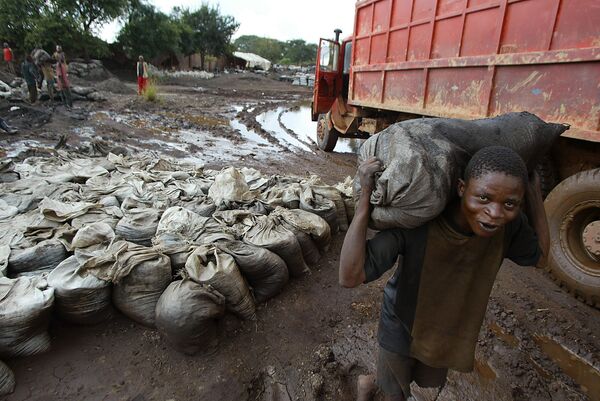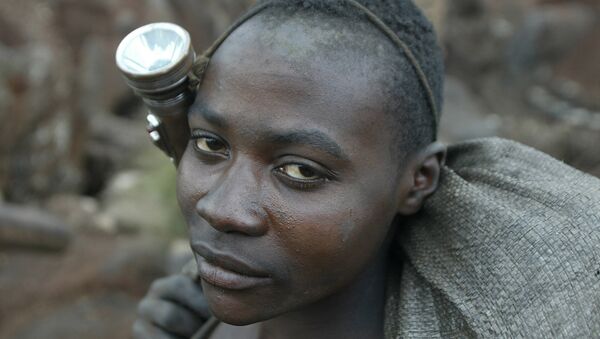Coltan and cobalt are the two main materials mined for on a daily basis in the Democratic Republic of Congo (DRC). Both are key components within everyday products — from mobile phones, laptops and jewelry. However, extracting these materials means using child slaves.

Non-government organizations, academics, and charities have shown that there is a strong link between the mining of these minerals and the role they play in funding violent armed groups as well as using child labor in mines.
#ChildLabour protest outside #Apple store in #Brussels today @amnestybe https://t.co/gkc52yuZBM pic.twitter.com/T1QmHLQWhl
— Thomas Coombes (@T_Coombes) June 11, 2016
Action @amnestybe & @amnestyvl dvt l'Apple store de #Bruxelles: non au travail des enfants https://t.co/Y9eo7hmQ7a pic.twitter.com/1eaFJD5GZ8
— Amnesty Belgique (@amnestybe) June 11, 2016
According to Amnesty International, the demand for these materials is growing daily. Lauren Armistead, Campaign Coordinator for Amnesty, said that cobalt demand is growing at over 5 percent a year, and it is expected to continue.
"More than half of the world's total supply of cobalt comes from the Democratic Republic of the Congo (DRC). According to the government's own estimates, 20 percent of the cobalt currently exported from the DRC comes from artisanal miners in the southern part of the country," Armistead told Sputnik.
The question remains however, as to why these minerals are being used to make mobile phones and is there an alternative?
Academic, Dr Phil Clark from SOAS University, has been researching this area for many years, believes that the reason minerals such as coltan are ideal for the manufacture of mobile phones comes down to the simple fact that they are cheap, malleable, and heat-resistant. They can also hold a steady electrical charge.
"Mobile phone companies have generated a multibillion dollar resource race for coltan and similar minerals because of their rare and lucrative qualities," Dr Clark told Sputnik.
The process of extraction is also very harmful. Dr Clark said the mineral is often extracted using out of date gold-mining techniques, which include panning for minerals in streams and rivers, as coltan is a highly toxic substance before it is refined. Therefore, workers who pan for it are often contaminated and get ill.
Amnesty International gathered evidence from several child slaves, who documented what had happened to them while mining for these materials.
#Fact Mobile phones & other electronics contain minerals found in the #Congo Basin. Be a part of the solution & #recycle your old phone.
— JaneGoodallInstitute (@JaneGoodallInst) January 26, 2016
The children that were interviewed told Amnesty that they worked for up to 12 hours a day in the mines, carrying heavy loads of between 20 and 40kg. Even those children who went to school worked 10 — 12 hours during the weekend and school holidays. The children who were not attending school worked in the mines all year round, because they or their parents cannot afford to send them.
One such example was of a young boy named Paul, aged 14, who started mining at the age of 12 and worked in tunnels underground. He told Amnesty that he would often spend 24 hours down in the tunnels.
"I arrived in the morning and would leave the following morning," he said.
These accounts are supported by Dr Phil Clark, who describes how many of the children are forced by rebel groups and other armed actors to pan for coltan in filthy rivers and streams, subjected to the toxicity of the minerals they handle as well as the dirtiness of the waters they wade into.
Batteries in your phone, rechargeable gadgets, EV etc contain a lot of cobalt. Over 1/2 world's supply is from Congo pic.twitter.com/bZVyQLyjuo
— chrispydog (@chrispydog) June 7, 2016
The children are paid less than US$1 per day to perform this dangerous work and the lasting effects are very bad.
"Chronic exposure to dust containing cobalt can result in a potentially fatal lung disease, called 'hard metal lung disease.' Inhalation of cobalt particles can also cause 'respiratory sensitization, asthma, shortness of breath, and decreased pulmonary function,' and sustained skin contact with cobalt can lead to dermatitis. Yet we found that the vast majority of miners, both adults and children, who spend long hours every day working with cobalt, do not have the most basic of protective equipment, such as gloves, work clothes or facemasks," said Lauran Armistead.
But does an alternative exits? Well, according to Dr Phil Clark there is a simple solution that can end the use of child labor.
"80 percent of the world's coltan comes from Brazil, Canada and Australia where the mining sector is more regulated and coltan extraction is typically machine-driven rather than the panning by hand techniques used in the DRC and elsewhere," Dr Phil Clark told Sputnik.
For Amnesty the solution is also simple, to place pressure on the companies who source these materials, so that more stringent regulations are imposed, which means children are not exploited.
"The attention that our report has gained, the people who have signed our petition, taken part in protests outside the Apple store, has shown that consumers want to know that big brands, including Apple, are checking their supply chains for child labor and addressing it. I have an iPhone, and I want to know that Apple is checking their supply chain for child labor and addressing it where they find it," Armistead told Sputnik.


